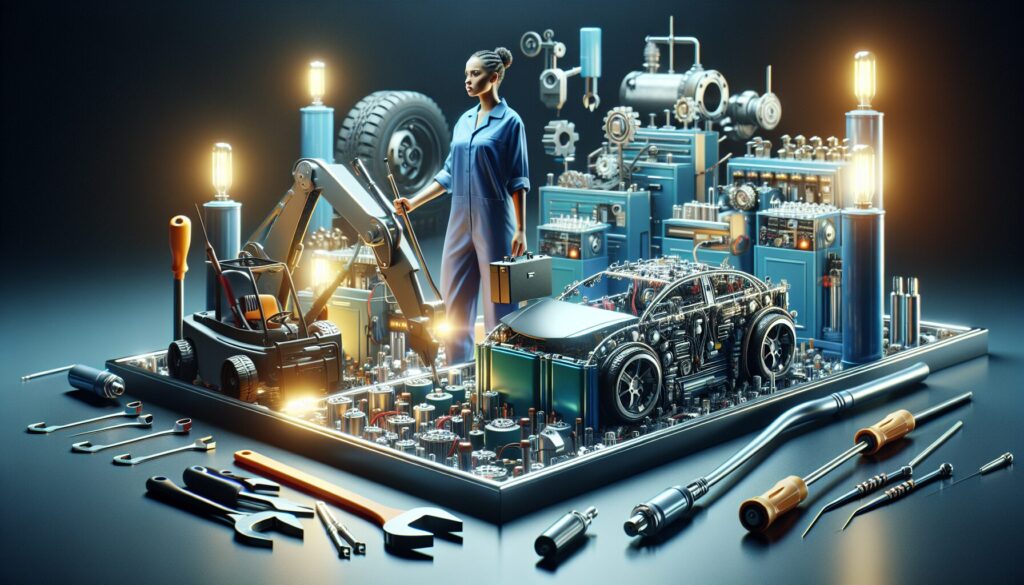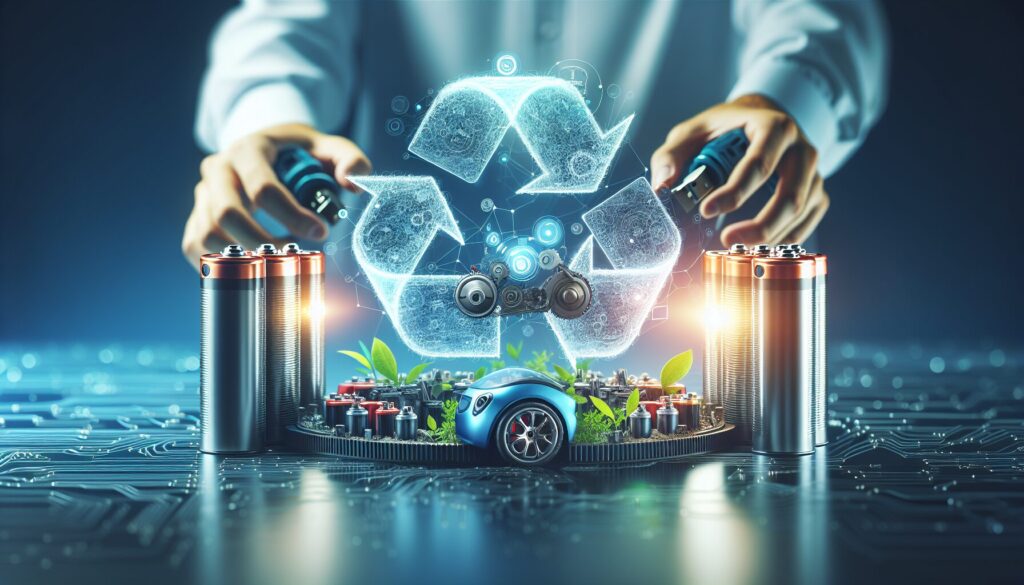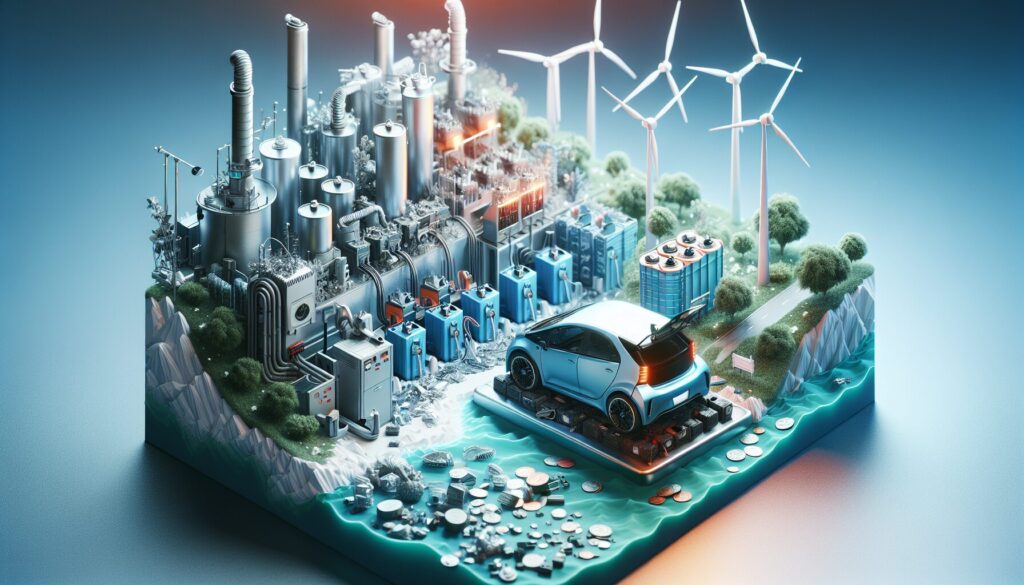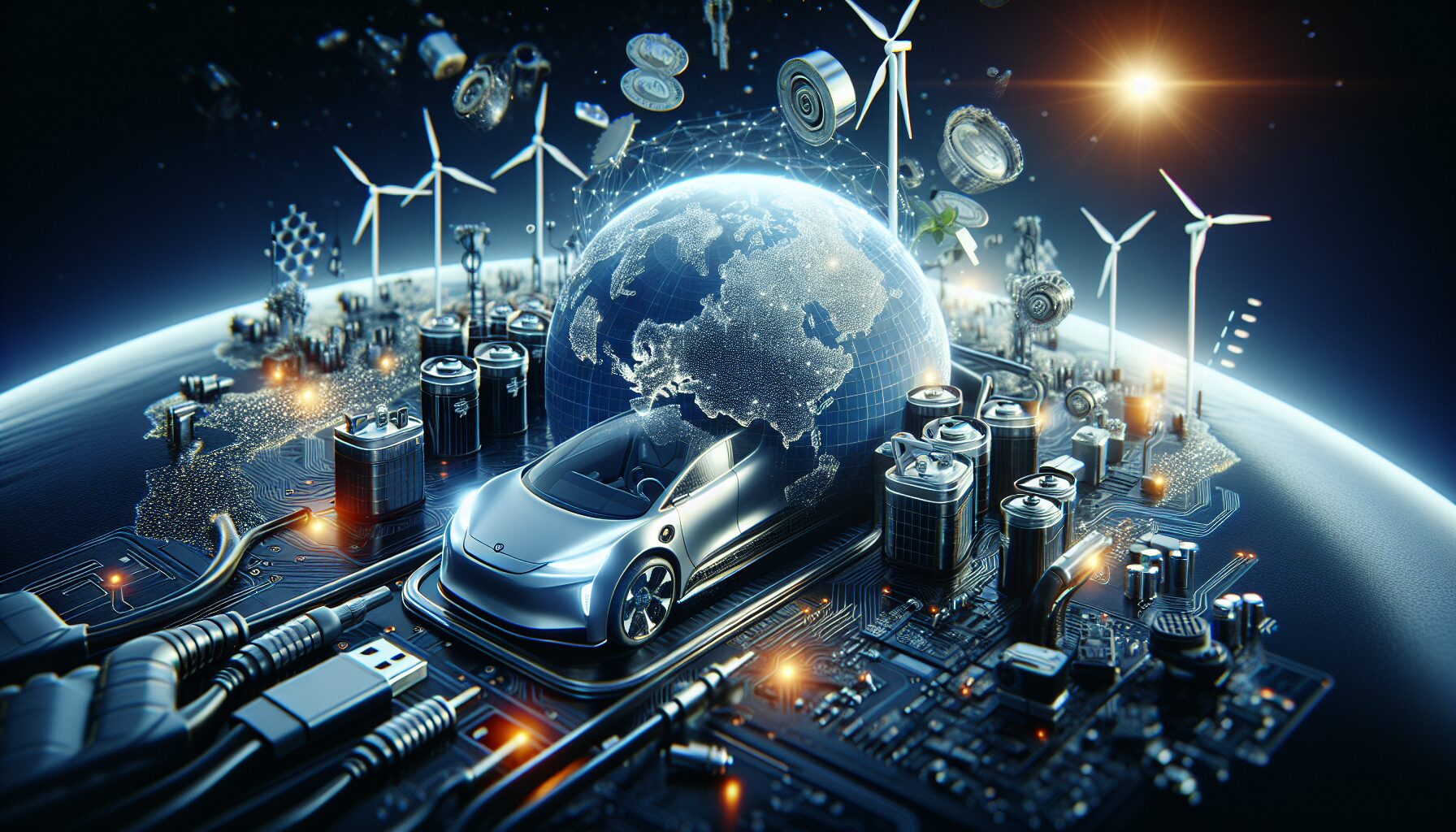Hey there! Let’s dive into the world of battery recycling for electric vehicles. It’s a fascinating topic, especially when you realize how crucial it is for our planet’s future. I remember chatting with a friend who’s got a knack for chemistry. She explained how the hydrometallurgical recycling process is used to recover valuable materials from lithium-ion batteries. It’s like giving these elements a second life! In this process, batteries are dissolved in acids, allowing the recovery of metals like lithium, cobalt, and nickel. Then there’s the pyrometallurgical method, which uses high temperatures to extract metals. This technique is efficient but requires more energy. Companies like Tesla and Redwood Materials are leading the charge in advancing these technologies. Isn’t it amazing how innovation can help reduce waste and promote sustainability? Let’s keep the conversation going and explore how these advancements impact us all.
Why Battery Recycling is Crucial for Sustainability
Imagine this: You’re driving down a scenic highway in your electric vehicle, the wind in your hair and not a care in the world about emissions. It’s not just a futuristic dream—it’s happening right now! But have you ever paused to think about what happens to your EV’s battery once it reaches the end of its life? That’s where the magic of battery recycling comes in, and it’s absolutely crucial for a sustainable future.
Let’s get into the nitty-gritty. When I first learned about the direct cathode recycling method, I was amazed at how it could retain the original structure of the cathode material. It’s like giving your battery a second life, without the hefty environmental cost of mining new resources. And speaking of resources, did you know that recycling batteries can significantly reduce our dependence on raw materials like cobalt and lithium? These materials often come from regions with questionable mining practices. By recycling, we’re not just protecting the environment; we’re also supporting ethical sourcing.
The Environmental Impact
Furthermore, recycling batteries minimizes landfill waste. Batteries that end up in landfills can leak harmful chemicals into the soil and water. That’s a big no-no for our planet. Plus, recycling processes like hydrometallurgical processing use fewer resources compared to mining and refining new materials. This means less water usage and fewer greenhouse gas emissions. It’s a win-win!
Then there’s the economic angle. Newer recycling technologies are creating jobs and driving innovation. Companies like Redwood Materials are at the forefront, showing us that sustainability can be profitable. The industry is booming, and it’s only going to grow as electric vehicles become more common. Local job creation means a stronger economy and a healthier planet. Who wouldn’t want that?
Finally, let’s talk about energy security. By recycling and reusing materials, the United States can reduce its reliance on foreign imports. This is particularly important for strategic materials like lithium. Having a steady supply from recycling ensures that we can continue to develop and expand our EV infrastructure without hitting resource roadblocks. It’s all about maintaining that energy independence.
Current Technologies in EV Battery Recycling

Picture this: you’re cruising down the highway in your electric vehicle (EV), feeling good about reducing your carbon footprint. But have you ever wondered what happens to the batteries when they reach the end of their life? The world of EV battery recycling is buzzing with innovation, and it’s more exciting than you’d think!
First off, let’s dive into some of the current technologies making waves. Remember my trip to the Redwood Materials facility last year? Their approach to recycling using hydrometallurgical processing was nothing short of fascinating. I got to see firsthand how they extract valuable materials with such precision. Battery Management System (BMS) diagnostics play a crucial role here, ensuring each battery is thoroughly analyzed before recycling. This level of detail is what sets effective recycling methods apart from the rest.
Innovative Methods and Key Players
Continuing our journey, the direct cathode recycling method is another game-changer. It allows for the direct recovery of cathode materials, which is a huge win for efficiency and sustainability. During a recent conference, experts from Battery Innovation Center discussed how it’s revolutionizing battery recycling. They highlighted how this method minimizes energy consumption compared to traditional practices. It’s truly a step forward in making EVs even greener.
Moreover, the pyrometallurgical method still holds its ground as a reliable technique. It’s been around for a while, but with new tweaks and advances, it’s becoming more eco-friendly. The high-temperature processes involved are being optimized to reduce emissions and energy use. This balance of old and new technologies is crucial for a sustainable future.
Interestingly, the demand for these recycled materials is skyrocketing. According to Bloomberg, the market for recycled battery materials is expected to grow exponentially in the coming years. This surge is driving companies to innovate and improve their recycling methods constantly.
For those curious about what happens next for these batteries, there’s a whole world of possibilities. Many recycled batteries are repurposed for second-life applications in energy storage systems. These systems are becoming integral to our energy infrastructure. If you’re keen, check out how these second-life batteries contribute to a sustainable future by exploring our article on second-life applications for electric vehicle batteries.
So, as you can see, the world of EV battery recycling is vibrant and ever-evolving. With key players and innovative methods in place, we’re on the right track to a sustainable future.
Innovations and Future Trends in Recycling

Imagine this: You’re sipping your morning coffee, reading about how battery recycling technologies are evolving to make electric vehicles even more sustainable. I remember when I first dove into the world of recycling tech. It was like opening a treasure chest of innovation. Did you know that companies like Redwood Materials are pioneering ways to improve these processes? Their work is not only fascinating but critical for our eco-friendly future.
One of the coolest trends I’ve seen is the move towards more efficient hydrometallurgical recycling. It’s all about using less energy and getting more valuable materials back. This method is not only eco-friendly but also cost-effective, which is a win-win for everyone involved. It’s exciting to think about how these innovations will shape the future of battery recycling.
The Role of Direct Cathode Recycling
Another game-changer in this field is direct cathode recycling. It’s like giving batteries a second life without breaking them down completely. This method helps retain the cathode’s original properties, leading to a more sustainable cycle of reuse. Imagine the impact if this becomes the norm! It could drastically reduce the environmental footprint of battery production.
Then there’s the pyrometallurgical process, which has seen some upgrades too. While it’s been around for a while, new innovations are making it more efficient. Modern techniques reduce the carbon emissions traditionally associated with this method. It’s pretty neat how technology can transform even the most established processes.
But where is all this innovation heading? Well, the future looks bright, with more companies investing in research and development. It’s not just about recycling anymore; it’s about creating a closed-loop system. This means every battery component can be reused, enhancing sustainability efforts.
Take, for instance, the advancements in the Battery Management System. It’s becoming more sophisticated, allowing for better monitoring and recycling compatibility. When I first learned about this, it blew my mind how interconnected these systems are.
Additionally, partnerships between tech companies and automakers are essential. They drive forward these innovations and ensure that new recycling technologies are implemented effectively. Imagine a world where every electric vehicle comes with a built-in plan for recycling. It’s not just a dream—it’s becoming a reality thanks to these collaborations.
In conclusion, the future of battery recycling for electric vehicles is incredibly promising. With ongoing advancements and a collective push towards sustainability, we’re on the verge of a green revolution. Organizations like Redwood Materials are leading the way, ensuring that our journey towards eco-friendly transportation is both exciting and achievable.
Challenges in Recycling EV Batteries

Oh, the challenges of recycling electric vehicle (EV) batteries! It’s like untangling a giant ball of yarn. You know, the kind that looks simple at first, but the more you pull, the more complicated it gets. Back when I first learned about battery recycling technologies, I was fascinated by the hydrometallurgical recovery process. Imagine using chemical leaching to extract valuable metals like lithium and nickel. It’s delicate and precise, much like a chef crafting a gourmet meal! However, this method isn’t without its hurdles.
One major issue is the environmental impact. Hydrometallurgical processes can lead to wastewater challenges, which makes it crucial to manage and treat the effluents effectively. Not to mention, the energy required to power these recovery processes can be quite substantial. It’s a balancing act between reclaiming valuable materials and minimizing ecological footprints. And let’s not forget the direct recycling methods for lithium-ion batteries. These are promising but still relatively new. The biggest challenge here is maintaining the integrity of the battery materials during the process. If you don’t get it just right, the materials lose their effectiveness.
Technical and Economic Hurdles
Besides the technical complexities, there are economic factors to consider. Pyrometallurgical techniques for cobalt extraction are energy-intensive and costly. The high temperatures required can lead to increased operational costs. This, in turn, affects the overall economics of recycling EV batteries. Who would have thought that reclaiming cobalt could be such a hot topic? (Pun intended!) Therefore, companies like Redwood Materials are constantly innovating to improve efficiency and reduce costs.
Additionally, the market for recycled materials is still developing. Fluctuating metal prices can impact the profitability of recycling operations. Creating a stable and predictable market for recycled battery materials is essential. Companies and governments need to collaborate to establish standards and incentives. This will ensure the growth of recycling technologies. Furthermore, policy and regulation play a significant role. Stringent guidelines can either help or hinder the development of effective recycling methods.
While these challenges are significant, they’re not insurmountable. Innovations continue to emerge. For example, breakthroughs in direct cathode recycling methods show promise. They offer a way to recycle without the need for energy-intensive steps. These advancements could revolutionize how we approach battery recycling. If you’re curious about how these innovations might extend the life of EV batteries, you might want to explore innovative second-life applications for electric vehicle batteries. It’s a fascinating area with lots of potential!
The Environmental Impact of Recycling Technologies
When I first heard about battery recycling, I was amazed by how complex and impactful it is on our environment. I remember a time when I visited a local recycling plant and saw firsthand how processes like lithium-ion battery hydrometallurgical recycling and direct cathode recycling processes are used. It’s pretty fascinating to watch, especially knowing how these technologies can significantly reduce our carbon footprint.
Recycling technologies for electric vehicle batteries help minimize the environmental impact in several ways. First, they reduce the need for raw material extraction. Mining for materials like lithium and cobalt is not only resource-intensive but also environmentally damaging. By using processes like pyrometallurgical smelting techniques, we can recover and reuse these valuable materials. This reduces the demand for new mining operations, which often leads to deforestation and habitat destruction.
Reducing Waste and Emissions
Another critical environmental benefit is the reduction of waste. Traditional battery disposal methods can lead to toxic chemicals leaching into the soil and water. However, advanced recycling methods ensure that most components are efficiently processed and reused. This not only cuts down on waste but also limits pollution. For instance, direct recycling methods are particularly effective in preserving the structural integrity of battery components, allowing them to be repurposed with minimal loss.
Moreover, these recycling technologies help decrease greenhouse gas emissions. For instance, hydrometallurgical recovery processes are designed to consume less energy compared to traditional mining and refining activities. By using these methods, facilities can significantly lower their carbon emissions, contributing to a cleaner and healthier environment. This is crucial as we strive to meet global climate goals and reduce our reliance on fossil fuels.
Additionally, companies like Redwood Materials are leading the charge in creating closed-loop systems. These systems ensure that materials from old batteries are continually recycled into new ones, creating a sustainable cycle. This not only reduces environmental impact but also promotes economic growth by creating jobs in the recycling industry. Furthermore, the Battery Management System plays a pivotal role in ensuring that batteries are used efficiently and recycled effectively, further limiting their environmental footprint.
In conclusion, the environmental impact of battery recycling technologies for electric vehicles is profound. By reducing the need for new materials, cutting down on waste, and lowering emissions, these technologies offer a sustainable path forward. Embracing these methods not only benefits our planet but also supports a greener future for generations to come.
Conclusion
Ultimately, the strides being made in electric vehicle battery recycling signify a promising shift towards a more sustainable and eco-friendly future. By innovating and refining recycling technologies, we not only mitigate environmental damage but also foster economic growth and energy independence. As we continue on this path, it is crucial to support these advancements and embrace the opportunities they present for a cleaner planet. Keep charging forward!
Continue Exploring
Unlock the power of connectivity and discover the best ways to stay charged in the heart of Australia's countryside. Find out how to keep your devices powered no matter where you are.
Frequently Asked Questions
What are the leading technologies for recycling electric vehicle batteries?
The leading technologies for recycling electric vehicle batteries include pyrometallurgical, hydrometallurgical, and direct recycling methods. Pyrometallurgical processing involves high-temperature melting to recover metals, while hydrometallurgical techniques use aqueous chemistry to extract materials at lower temperatures. Direct recycling aims to preserve the battery’s structure to reuse components, offering a more sustainable approach.
How does battery recycling impact the sustainability of electric vehicles?
Battery recycling significantly enhances the sustainability of electric vehicles by reducing the demand for raw materials, minimizing environmental impact, and lowering the carbon footprint associated with battery production. By reclaiming valuable materials like lithium, cobalt, and nickel, recycling technologies help conserve natural resources and support a circular economy.
What challenges do current battery recycling technologies face?
Current battery recycling technologies face several challenges, including technological limitations, economic viability, and regulatory hurdles. Efficiently recovering high-value materials while minimizing waste and energy use is technically demanding. Additionally, establishing a robust recycling infrastructure and ensuring compliance with environmental regulations are crucial for widespread adoption and success.


Leave a Reply